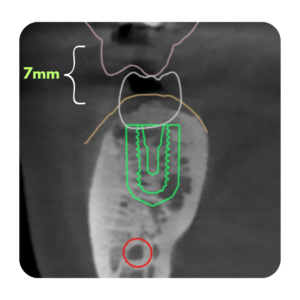Hey guys I want to share this thing called the Decompression Technique. My friend, @dr_mataria_dds brought it to my attention and there is a great article published about it here.
But I’d love to summarize it for you.
The idea is that tissue can put pressure on our bone graft. If we’re trying to augment something, but we have tissue pulling back on it, we will likely have less than ideal results.
But what if we could do something pretty easily that would help relieve that tissue pressure?
In cases such as this:

(Source)
Don’t you hate when you don’t have enough bone on the buccal? If you’re like me, you’d most likely bury that a bit deeper and then graft and put a cover screw on. Right? Well these peeps have a solution for ya, it’s called the Decompression technique. Switching to a 2mm BURIED HEALING ABUTMENT instead of a cover screw can actually create space for you and relieve that stress. This helps shift pressure from the implant collar to the healing abutment.
So in the case example, the implant was placed in a thin ridge, and you’ll notice that there were still some threads exposed on the buccal. After the implant was placed, bone chips were harvested from the patient with a scraper, and mixed with an allograft.


Then a collagen tissue matrix derivative membrane (Mucoderm®, Botiss Biomaterials) was placed over everything and closed up. This membrane was used in an effort to thicken the soft tissue thickness. The authors recommend a STH of 3-4 mm is recommended for long-term results.

Then a 2mm healing abutment was used instead of the traditional cover screw in order to release pressure from the bone level around the implant and instead shift that pressure towards the healing abutment instead.
In theory, this allows more bone to be maintained and even, in this case, to be augmented.

And here is the beautiful follow up pictures of that case, of course showing circumferential bone around that implant.

Note:
I had sort of informally done this technique in my residency, but I was making one critical mistake. I placed the healing abutment and hoped that the tissue would grow over it, but often the tissue never closed all the way over. The reason is that I didn’t properly treat it as an actual GBR procedure and I didn’t release the tissue enough so that it would close over. So make sure to release the tissue enough so that it will easily close up over your healing abutment.
My friend, Dr. Mattaria, shared some pictures of the technique and his results here. Not too shabby!


Why is this helpful/relevant?
Buccal thread exposure is a common problem in the mandible. This presents an easy fix that you can do at time of implant placement.
Highlights:
- Tissue can put pressure on our bone graft. If we have tissue pulling back on bone, we will likely have less than ideal results.
- Switching to a 2mm BURIED HEALING ABUTMENT instead of a cover screw can actually create space for you and relieve that stress.
- Implant Placed, buccal bone exposed.
- 2mm Healing abutment placed
- Graft Placed over it, autogenous bone chips + allograft mixed.
- collagen tissue matrix derivative membrane (Mucoderm) placed to thicken up tissue.
- Tissue relieved for tension free closure
- Diagram of how this all looks under the tissues
- Results of graft




Responses